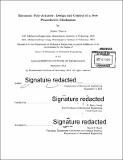Harmonic poly-actuator : design and control of a new piezoelectric mechanism
Author(s)
Torres, James, Ph. D. Massachusetts Institute of Technology
DownloadFull printable version (16.88Mb)
Other Contributors
Massachusetts Institute of Technology. Department of Mechanical Engineering.
Advisor
H. Harry Asada.
Terms of use
Metadata
Show full item recordAbstract
Piezoelectric devices, e.g. piezoelectric stack actuators, have several salient features inherent to their structure. They are efficient, have a high bandwidth, and their capacitive loading allows for static loads to be maintained with virtually no power consumption. The major preventative drawback that limits more widespread use is the small strain, on the order of 0.1%. For marco-scale applications, the displacement must be amplified, typically through mechanical or frequency leveraging. Both have inherent limitations: mechanical devices can increase the stroke but is naturally limited; and frequency devices relies on friction and is limited to nanopositioning. In this thesis, we investigate combining a unique mechanical amplification with a frequency amplification device that does not rely on friction to produce an arbitrarily large stroke linear actuator. The first stage of amplification aims to achieve the greatest displacement amplification without sacrificing force capabilities. The second stage relies on the coordinated actuation of multiple copies of the mechanically amplified device to produce a long stroke, smooth force poly-actuator. The theoretical design concepts for each stage of amplification are explicitly derived. The mechanical amplification device uses rolling contact joints to maintain stiff connections to transmit the force without losses due to friction; and the frequency amplification uses a sinusoidal Transmission interface to exploit a passive balancing of undesirable non-linearities, proven by harmonic analysis. A unique control algorithm is developed to produce a wide variety of capabilities. The theoretical findings are supported by experimental prototypes. The mechanical amplification device produces a comparable energy density while amplifying the displacement by an additional factor 10. The proof-of-concept poly-actuator prototype can continually produce +/-100 Newtons of force over a stroke of 200 mm. We conclude with simulations, which are verified through physical experiments, used to estimate several performance metrics for comparison.
Description
Thesis: Ph. D., Massachusetts Institute of Technology, Department of Mechanical Engineering, 2015. Cataloged from PDF version of thesis. Includes bibliographical references (pages 127-132).
Date issued
2015Department
Massachusetts Institute of Technology. Department of Mechanical EngineeringPublisher
Massachusetts Institute of Technology
Keywords
Mechanical Engineering.